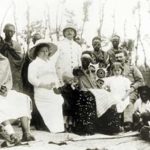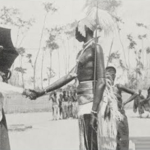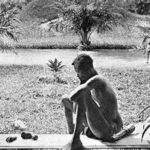Lineages And Hill Chiefs
The hillchiefs introduced to Kinyaga from the time of Rwabugiri resembled lineage heads in several respects. They collected prestations, settled disputes, and served as intermediaries to outside authority. But unlike the lineage heads they displaced, each hill chief (umutware w’umusoozi) was appointed from above, by a politically more powerful superior, the provincial chief; the hill chief relied less on support from below than on power transmitted through the administrative hierarchy. Initially the area administered by a hill chief was fairly small, ranging from a small portion of a hill(umurenge) to an entire hill (umusoozi) or, less frequently, several hills. Later during regroupment under Belgian rule, these small administrative units were consolidated into larger entities (subchiefdoms), each headed by a sub-chief.
Many of the early hill chiefs were appointed from Kinyagan lineages, to collect prestations from people in their own area, including their kinsmen. Particularly in Abiiru the provincial chief often selected as his delegate a member of a large and wealthy local lineage; the delegate might be the incumbent lineage head, or some other member. Later during the European period subchiefs were usually recruited from outside Kinyaga. When a Kinyagan was appointed, he was seldom posted to his natal. bill. But whether the hill chief was appointed from a local lineage on the hill or imposed from outside, a significant change had occurred. Henceforth, other lineages on the hill found themselves subordinated to the authority of one person, whose position depended on his ability to please superiors in the patron-client network.
The power of hill chiefs to control resources became an important incentive for Kinyagans to seek ubuhake patrons, just as at a higher level ubuhake clientship was an important mechanism in recruiting hill chiefs. The effect of these changes on individual lineages varied, of course, depending on local circumstances. But the general impact was to diminish the political role of the legitimate lineage heads. A brief case study will help to clarify the complementary roles of ubuhake patron and hill chief in the erosion of lineage autonomy.
Nduruma was the founder of the Abaruruma lineage at Cyete in Abiiru region; he lived during the reign of Umwami Rwogera, when there were no hill chiefs as such in Kinyaga. As head of his lineage, Nduruma was the principal political authority on his hill, a position he shared with the lineage head of the Abageshi, the other numerically strong lineage at Cyete. The Abaruruma were Tuutsi; the Abageshi were Hutu.
Nduruma’s designated successor, Rukubita witnessed the introduction of hill chiefs into Kinyaga. Aside from assuming the powers formerly held by his father, Rukubita became the local representative of the Abiiru provincial chief, Rubuga (who had himself been appointed by Rwabugiri. The extent of Rukubita’s jurisdiction is not clear, but he apparently acquired authority over other lineages on the hill in addition to his own; he became hill chief (umutware w’umu
soozi) representing Rubuga, and he combined this role with that of lineage head.
When Rwabugiri was preparing hisfinal expedition against Bushi, he assigned several hills near the Rusizi River to a prominent army chief, Seemakamba. One of the hills was Cyete, home of Rukubita’s lineage; Cyete was withdrawn from the jurisdiction of the Abiiru provincial chief and placed under Seemakamba’s authority. Seemakamba dismissed Rukubita from his position as hill chief, and replaced him with Nduruma’s grand-nephew, Seebutimbiri.
Seebutimbiri distinguished himself in war, and he acquired prestige and power as ubuhake client of Seemakamba. The new hill chief came to be regarded as “leading member” of his lineage. ButSeebutimbiri was not the legitimate lineage head of the Abaruruma. His status depended not on his role within the lineage but on the favor of his patron, Seemakamba. The locus of power had thus shifted from one branch of the lineage to another, and from representative to delegated power. Moreover, though technically Seebutimbiri’s role was restricted to his functions as hill chief, these tended to spill over into what had previously been the domain of the lineage head.
When the Abapari and Seevumba invaded Kinyaga, Seebutimbiri took a leading role in the attempts to repel them. He was killed in the conflicts, and the position ofhill chief reverted to the Rukubita branch; a nephew of Rukubita took over, representing Seevumba at Cyete, but his tenure ended with Seevumba’s departure. From that time the lineage held no further administrative posts; a man from another lineage gained administrative authority over Cyete hill, and the position of lineage head of the Abaruruma retumed to Seebutimbiri’s line. The introduction of hill chiefs and clientship provided opportunities for social mobility to some members of the Abaruruma lineage; power gravitated toward those who were willing and able to attract favor from political superiors. But this new status was precarious. Power oscillated between different branches of the lineage, reflecting the changing political fortunes of lineage members’ patrons-Rubuga, Seemakamba, Seevumba. Ultimately, authority within the lineage was divided, and the past political role of the lineage was undermined
https://uk.amateka.net/lineages-and-hill-chiefs/https://uk.amateka.net/wp-content/uploads/2019/10/art.jpghttps://uk.amateka.net/wp-content/uploads/2019/10/art-150x150.jpgChanges and ColonialismThe hillchiefs introduced to Kinyaga from the time of Rwabugiri resembled lineage heads in several respects. They collected prestations, settled disputes, and served as intermediaries to outside authority. But unlike the lineage heads they displaced, each hill chief (umutware w'umusoozi) was appointed from above, by a politically more powerful...BarataBarata rpierre@ikaze.netAdministratorAMATEKA | HISTORY OF RWANDA




